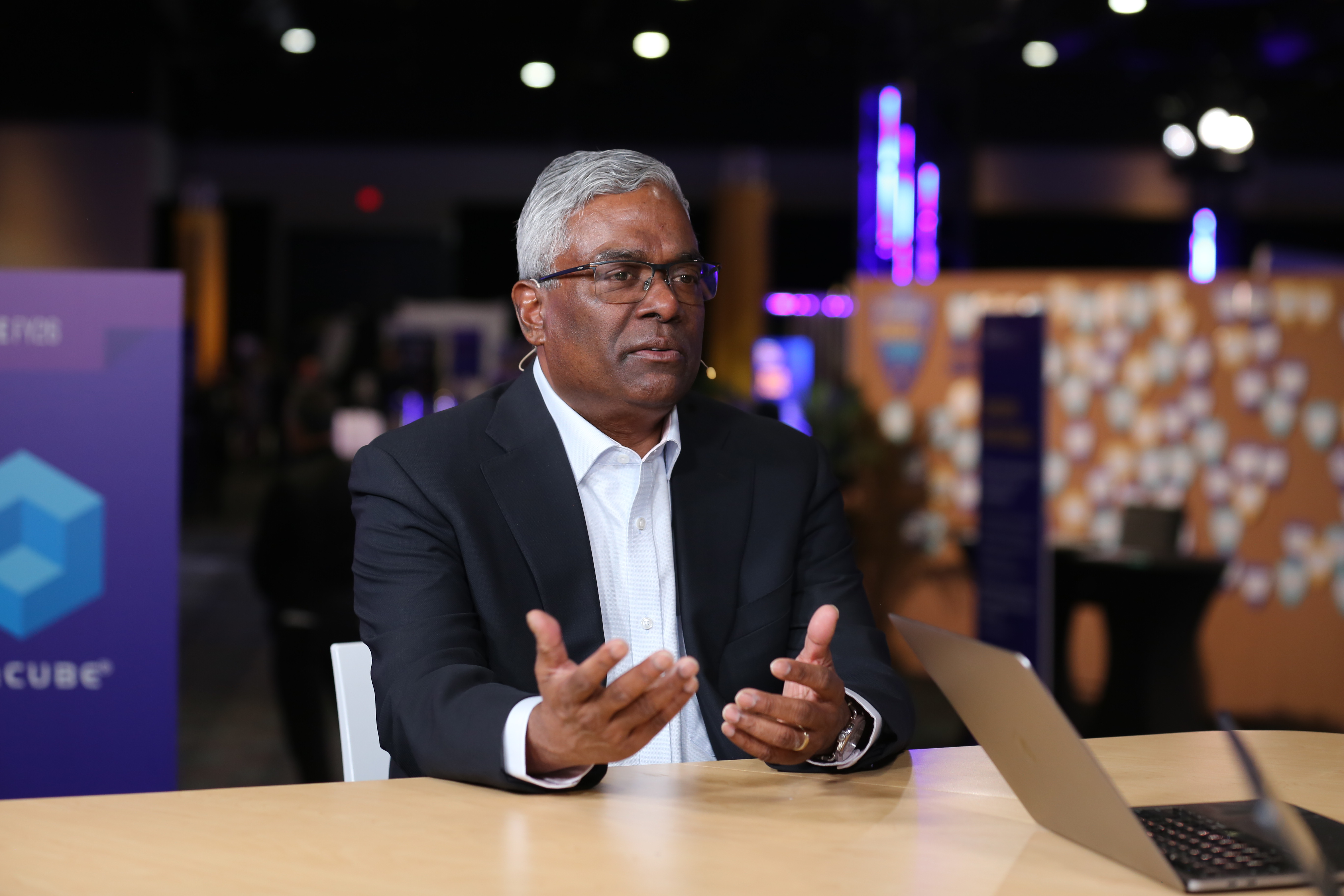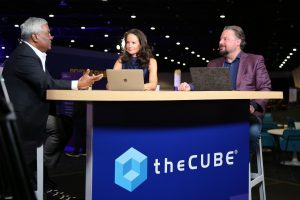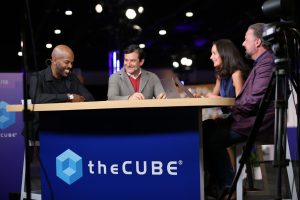 AI
AI
 AI
AI
 AI
AI
In a world shaped by AI and data infrastructure, NetApp Inc. is choosing nuance over noise. Chief Executive Officer George Kurian frames the company’s mission as helping enterprises anchor meaning in a sea of data — rather than simply chasing trends.
For Kurian (pictured), NetApp’s approach reflects a deeper ethos — one rooted in long-term responsibility rather than short-term wins. He views leadership as a commitment to progress that endures, aligning innovation with purpose and drawing on a lineage of data as a vessel for human connection and understanding.

NetApp’s George Kurian talks with theCUBE about the company‘s forward-looking strategy.
“We are in a long line of innovators starting from 25,000 years ago, where people have tried to record data as a way to share their stories and the meaning of life to succeeding generations,” Kurian said. “It requires us to act with humility, personal accountability, a sense of respect and a drive for excellence in the way we work.”
During the “Architecting Outcomes in the Era of Intelligence” event, Kurian and other NetApp executives, partners and customers, including the San Francisco 49ers, the Aston Martin Formula One Team (AMF1) and more, talked with theCUBE Research’s Rob Strechay and theCUBE’s host Rebecca Knight. Their conversations focused on the company’s Intelligent Data Infrastructure strategy, with a vision to manage risk, empower artificial intelligence and ensure performance at scale. (* Disclosure below.)
Kurian identifies four key market drivers shaping NetApp’s strategy in the year ahead: Flash, AI, block and cloud. The company aims to maintain its leadership in flash, deepen partnerships with hyperscalers and use its experience navigating past transitions to capitalize on emerging AI momentum, according to Kurian.
“I think flash and AI are secular drivers, meaning a lot of players can participate in that,” he said. “Block and cloud are company-specific. In one, we have the opportunity to grow share, [and] in the other, we can capitalize on a really strong run that we have going on with the hyperscalers.”
Leadership through disruption, whether from AI, cloud adoption or shifting customer demands, requires both principle and pragmatism, according to Kurian. NetApp’s strategy avoids scattershot initiatives in favor of deliberate focus, embracing customer-first choices, even when they challenge legacy thinking.

NetApp’s Sandeep Singh talks with theCUBE about how the company is reinventing its storage solutions.
“If it’s good for our clients, we need to embrace it, even if it could be in the near term disruptive to our business,” Kurian said. “You cannot say ‘yes’ to every idea. A good strategy starts with saying ‘no’ to a bunch of things. If you look at our annual playbook, it’s really one or two things we’re asking our field and our product teams to go after.”
NetApp’s vision for enterprise storage aligns tightly with customers’ evolving AI and data priorities as well as security and performance needs. With AI-ready infrastructure now a prerequisite, storage has become far more than a passive repository: It’s the final line of defense and a launchpad for innovation, according to Sandeep Singh, senior vice president and general manager of enterprise storage at NetApp.
“NetApp’s contributions are really helping customers get that optimal price performance for every need [and] for every workload, but bringing all of the intelligent data services to help them protect their data [and] have it AI-ready,” Singh said. “Where NetApp is really helping to change the game and bringing the leadership capabilities is with real-time ransomware detection that is powered with AI and machine learning, and that is happening in a matter of seconds to minutes, not hours to days later.”
NetApp’s leadership helps customers turn AI and data into real-time decision-making power by delivering infrastructure that performs under pressure, according to Cesar Cernuda, president of NetApp. Whether supporting high-stakes racing or enterprise operations, the company aligns performance, scalability and security to the demands of mission-critical environments.
“Many of our customers are asking NetApp … saying what we need is to build an Intelligent Data Infrastructure that can really help to operationalize and work with their data anywhere,” Cernuda said. “If we’re not able to go and provide them the reliability that they need on their data — the performance, the scalability [and] the security — they will not be able to go and do what they’re doing every day.”
For global organizations operating in high-stakes, high-visibility environments, trust is earned through consistency, resilience and deep understanding of what’s at risk, according to Cernuda. NetApp brings a security-first mindset backed by its Six Nines Data Availability Guarantee and autonomous threat mitigation capabilities. It’s a commitment built not just on tech, but on decades of partnership and reputation.
“We say that we are the most secure data storage company on the planet,” Cernuda said. “And the reason for that is, we have brought out … capabilities inside our technology that help our customers to detect potential threats so they can stop very fast or act as soon as possible to them.”
From the precision of trackside decision-making to the massive scale of global entertainment, NetApp’s infrastructure flexes to meet performance needs across every arena. That foundation also anchors its role in powering the National Football League’s AI and data operations. As the league expands its international presence and deepens fan engagement strategies, NetApp enables unified access to sprawling data sets — from on-prem to cloud — to drive personalized, AI-powered interactions, according to Gary Brantley, senior vice president and chief information officer of the National Football League.
“You think about the Super Bowl, what, close to 34 terabytes … it’s one game,” Brantley said. “You think about the amount of viewership that’s watching those games and the amount of data that’s coming across through those experiences, it’s amazing. But … the NFL is making quality decisions based on the ability to really take advantage of their data. NetApp was a part of that.”
The San Francisco 49ers’ vision for an intelligent stadium draws heavily on NetApp’s data infrastructure to create immersive, real-time fan experiences. The team has expanded far beyond its origins as the “most connected stadium” to now support AI-driven services that anticipate crowd needs, personalize engagement and power data-intensive experiences such as 4K video boards, according to Costa Kladianos, executive vice president and head of technology at the San Francisco 49ers. The partnership supports game-day operations and long-term planning.

The NFL’s Gary Brantley and NetApp’s Cesar Cernuda talk with theCUBE about how technology and fandom are meeting in bold new ways.
“It’s reshaping how we do infrastructure at the stadium,” Kladianos said. “We needed a foundation that NetApp can provide … to get the data, transform the data and be able to make amazing decisions and engage our fans.”
NetApp’s deeper investment with the 49ers reflects a strategy of embedding itself in AI and data operations rather than sitting on the sidelines. The company plays an active role in co-developing AI-ready infrastructure that supports everything from stadium logistics to dynamic fan engagement, according to Gabie Boko, chief marketing officer of NetApp. That real-time adaptability is essential for customizing experiences and driving operational excellence.
“We were just talking … about where AI is going to be taking us [and] how we’re going to increase computational speed and storage access, and I think that is the basis of good analytics,” Boko said. “That is … where they want to go … to understand their fans, both from a security perspective, from an access perspective and from a need perspective.”
That same commitment to intelligent infrastructure shows up in speed-critical environments, such as Formula One racing. NetApp’s technology powers Aston Martin Formula One Team’s (AMF1) data-intensive engineering workflows, from wind tunnel testing to real-time telemetry at the track, according to Stuart Bailey, head of infrastructure for AMF1. The team uses FlexPod to connect its main campus with trackside infrastructure, enabling engineers to instantly analyze performance data across design, simulation and race-day conditions.
“If you put the right data in the right place and have the right people having access to it at the right time, that just drives innovation across the business … all the way up to the track as well,” Bailey said. “We’re a petabyte-scale organization and everything’s a giant feedback loop, so everything we build and develop at each stage feeds back into the development of the car.”
Ducati Corse, the racing division of Ducati Motor Holding, brings its own flavor of high-performance analytics under pressure. Unlike F1, MotoGP prohibits wireless data transfers from bikes to garages during a race. That restriction makes fast data offload and remote analysis even more critical, according to Davide Barana, technical director at Ducati Corse.
“We have only a few minutes to download the data, run the analysis to verify that everything is working fine and possibly propose setting changes,” Barana said. “This means that we have to be able to analyze fast, transfer the data from the track side to the headquarters in Bologna … to involve more engineers in the analysis process. This … can give you an idea of how NetApp is fundamental.”
Solution providers seek AI and data tools that reduce customer friction while offering partners rich service opportunities. NetApp’s AIPod Mini, developed with Intel Corp., is designed to lower barriers to entry by removing the need for deep data science expertise and enabling partners to focus on outcomes instead of complexity, according to Jenni Flinders, senior vice president, partner and channel at NetApp.
“It takes some of the fear out of this too, because you don’t need to have the complexity and that deep data science experience to get going with AI Mini Pod,” Flinders said. “That is fantastic for partners, because they can then wrap services around it, really go and help the customers get a line of sight into what that outcome is and how this can help [them].”
Beyond simplifying partner engagement, the AIPod Mini also delivers direct advantages for customers seeking fast, secure deployment. Built as a flexible offering, it works across environments with minimal setup and supports enterprise-grade security from the outset, according to Flinders.

TD SYNNEX’s Jessica Yeck, Intel’s Bill Pearson, and NetApp’s Jenni Flinders talk with theCUBE about how AI is reshaping partner ecosystems.
“What’s totally unique about this whole joint venture that we’re doing … it’s the product’s at the right price,” Flinders said. “It’s a full-stack offering … it’s actually something where customers can get instant results from. You put it in there and it works. Need I say, it is the most secure with NetApp ONTAP. As long as you’re running Intel Xeon, it’s fine. It’s vendor-agnostic as well, so whatever server you want to put in there.”
Many companies are still stuck in the proof-of-concept stage when it comes to AI, unsure how to translate ideas into real business value. Intel sees the market demanding solutions that allow customers to apply their own industry-specific data — without needing deep AI expertise — to deliver practical outcomes, according to Bill Pearson, vice president of data center and AI at Intel.
“I think when you look today, there’s a lot of AI solutions and a lot of people are experimenting with POCs and trying things out,” Pearson said. “They know the potential’s there, but realizing that potential and turning it into business value is the hard part. Companies are hungry for solutions that can help them take their specialized industry without specialized skill sets, apply AI, take their own industry data, their own company-specific data, and do something useful with it, turn it into business value.”
As the channel adapts to AI and data complexity, solution providers position themselves as essential guides for businesses navigating complexity and seeking faster outcomes. TD SYNNEX Corp. sees generative AI as a massive opportunity to drive efficiency and deepen customer relationships, according to Jessica Yeck, senior vice president for AI, data and business apps at TD SYNNEX.
“Generative AI is the largest opportunity in the channel right now, and companies are looking to tap into the efficiency gains that they are seeing as a result of the innovations brought by AI,” she said. “They’re looking to essentially make their teams more productive and bring more productive outcomes for their teams. In addition, this is an opportune time for solutions providers to be able to bring their expertise and their consultation to their customers to help them accelerate to AI outcomes much faster.”
To watch more of theCUBE’s coverage of the “Architecting Outcomes in the Era of Intelligence” event, here’s our complete event video playlist:
(* Disclosure: TheCUBE is a paid media partner for the “Architecting Outcomes in the Era of Intelligence” event. Neither NetApp, the sponsor of theCUBE’s event coverage, nor other sponsors have editorial control over content on theCUBE or SiliconANGLE.)
Support our mission to keep content open and free by engaging with theCUBE community. Join theCUBE’s Alumni Trust Network, where technology leaders connect, share intelligence and create opportunities.
Founded by tech visionaries John Furrier and Dave Vellante, SiliconANGLE Media has built a dynamic ecosystem of industry-leading digital media brands that reach 15+ million elite tech professionals. Our new proprietary theCUBE AI Video Cloud is breaking ground in audience interaction, leveraging theCUBEai.com neural network to help technology companies make data-driven decisions and stay at the forefront of industry conversations.